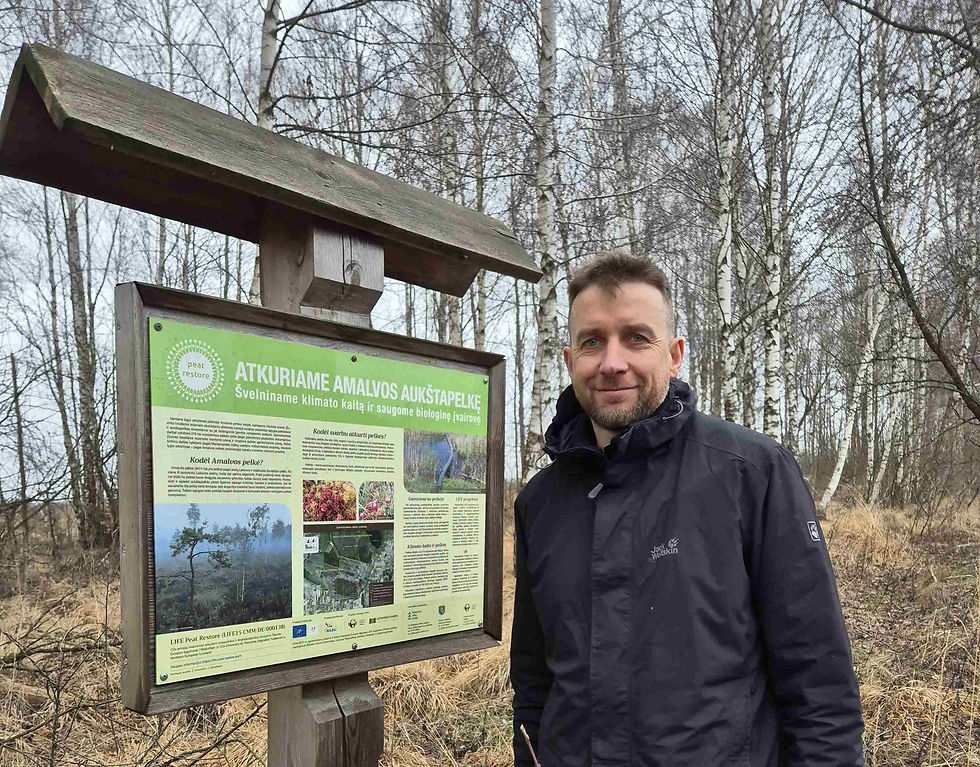Meeting on the restoration of peatlands and the establishment of a carbon credit system in Lithuania
- nerijus zableckis
- Jan 24, 2022
- 3 min read
On December 2 a meeting was held on the restoration of peatlands and the establishment of a carbon credit system. The meeting was initiated by the Association of Peat Companies “Lietuviškos durpės” in cooperation with the Lithuanian Fund for Nature and the Public Institution Wetlands Restoration and Protection Fund. The event was held in a hybrid way.
Presentations:
Charges for companies for the carbon component of peat used for heating were discussed during the meeting. Prospects for the future extraction of highly fragmented peat suitable for energy have been discussed, i. y. following the decision of the Government of the Republic of Lithuania to waive subsidies and to introduce a carbon dioxide component for peat for heating.

Representatives of the management of the Association of Peat Companies, together with members of the Association and other peat companies, discussed the need to start pre-rehabilitation of peat quarries before the planned operation is completed. It was emphasized that in order to carry out pre-remediation, it is necessary to change the peatland exploitation and remediation projects. Unfortunately, the costs of restoration of such peatlands would be significantly higher than provided in the initial recultivation projects, as the restoration activities are planned only after the complete completion of peat mining at the site, i. y. leaving only a 30 cm unexcavated layer of peat up to the technological level. In addition, the shortening of the operating period will reduce the part of the budget set aside for recovery. Leaving a thicker layer of peat and a more expressive (uneven) terrain complicates the restoration of such peatlands, as much more complex solutions are needed to help restore and maintain optimal water levels.
Another important issue discussed during the meeting was the improvement and / or restoration of wetlands as carbon storage ecosystems. In the modern world, there is a growing interest from legal and natural persons to voluntarily reduce their impact on the climate. One option is to offset a company's or institution's greenhouse gas (GHG) emissions by supporting natural ecosystem restoration projects that also contribute to reducing GHG emissions. Tree (forest) planting projects are already quite popular in the society, but the restoration of the hydrological regime of the wetlands damaged by drainage would obviously contribute to the solution of this problem. The restoration of viable wetland ecosystems is measured by CO2 savings (over the next 30-50 years), from which CO2 credits are generated, by which legal or natural persons contribute to the restoration of already damaged wetland ecosystems. In order to legitimize such activities, it is important to create a reliable, approved and transparent carbon credit system. Experts from the Wetlands Restoration and Protection Fund are working in this direction, based on a system already in place in Germany.
Currently, the Public Institution Wetlands Restoration and Protection Fund in Lithuania is implementing two pilot projects, which were presented to the participants of the seminar by the head of the fund N. Zableckis. It is a marsh in the vicinity of Baisogala, which is being restored in an extremely intensively drained meadow, and the Tartoko lowland marsh (Prienai). The efficiency of wetland restoration is assessed in accordance with the German standard MoorFutures and the emission calculation methodology (GEST).
NOTE: The event was held in compliance with the security requirements for public events related to the prevention of the spread of COVID-19 (coronavirus infection).








Comments